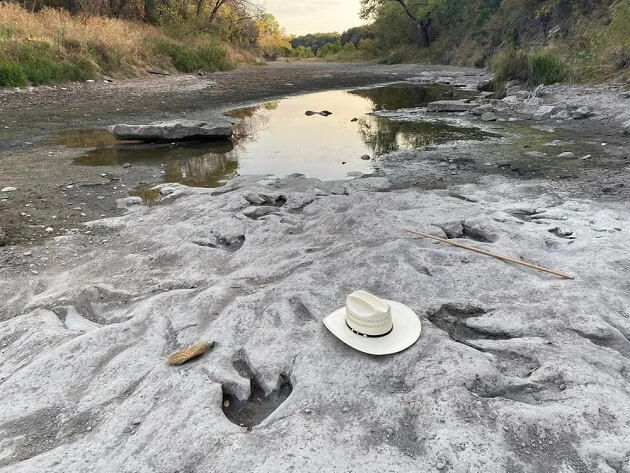
Drought Reveals 113-Million-Year-Old Dinosaur Tracks In Texas
The footprints are normally submerged under the water and silt of the Paluxy River, part of which has dried up this summer
By: Sarah Kuta | Smithsonian
Drought has dried up part of a river in central Texas, revealing 113-million-year-old dinosaur tracks.
The prehistoric footprints emerged at Dinosaur Valley State Park, which is located in the town of Glen Rose, southwest of the Dallas-Fort Worth area.
As the name suggests, the park already protects other dinosaur footprints. But the tracks that recently emerged are usually hidden under the mud, silt and waters of the Paluxy River. This summer, however, water levels have dipped so low that the prehistoric indentations are now visible. So far, volunteers have counted 75 newly exposed footprints in the parched riverbed.
“It has been another very hot, very dry year, so our researchers are trying to take advantage of the drought,” says park superintendent Jeff Davis to the Dallas Morning News’ Sarah Bahari.
600 Million Year Old Fossils of Tiny Humanoids Found In Antarctica
Two different types of dinosaurs likely made the footprints, according to park officials. One was Acrocanthosaurus a 15-foot-tall carnivore that weighed approximately 14,000 pounds. As the gargantuan reptile walked around the area on two legs, it left behind the outline of its three-toed feet. The other was Sauroposeidon proteles, which has been the official state dinosaur of Texas since 2009. This long-necked behemoth may have measured up to 100 feet long and weighed closer to 88,000 pounds. It left behind larger, bulbous-shaped tracks that are similar to elephant footprints.
One footprint appears to be a “double track”—an example of two overlapping Acrocanthosaurus tracks, as Davis tells KSAT’s Mary Claire Patton. (Or, as the non-profit Friends of Dinosaur Valley State Park joked on Facebook, a “huge 6 toed clawed prehistoric monster track.”)


When both types of creatures were walking around the area during the Cretaceous Period, they would’ve been stepping on the squishy mud of a shallow sea. Over time, however, that sediment solidified into limestone, which preserved the imprints for millennia. The sediment and water of the Paluxy River continue to protect the tracks, but eventually, they will erode away.
“Texas is blessed with a lot of good fossil occurrences,” as James Farlow, a palaeontologist at Purdue University Fort Wayne, told the New York Times’ April Rubin last year. “It’s a resource that is continually being destroyed but continuously being renewed.”
In the meantime, volunteers and researchers are using this opportunity to measure, document and study the tracks—though their work has not been without challenges. The limestone in the riverbed reached temperatures as high as 126 degrees Fahrenheit last week, according to a Facebook post by the Friends of Dinosaur Valley State Park.
Right now, all of Somervell County, which encompasses the park, is experiencing “Extreme Drought,” according to the latest assessment from the U.S. Drought Monitor. This is the second year in a row that drought conditions have revealed previously submerged tracks within the park. In 2022, a long trail of deep dinosaur footprints emerged as the river dried.
In 1909, a child named George Adams discovered dinosaur footprints while playing around in the Paluxy River, according to the park. Later, in 1937, palaeontologist R.T. Bird visited the area in search of fossils to take back to the American Museum of Natural History and identified even more prints. A section of the riverbed he collected in 1938, called the Glen Rose Trackway, is on display at the museum in New York City.
Even now, decades later, the footprints continue to “provide an understanding of where we fall as a species,” as Davis told the Dallas Morning News’ Jamie Landers last year.
“It brings it into reality,” he added. “You look at these and realize these were not movie monsters, these were animals that walked and lived in this place where I’m standing today.”
Other parts of the Lone Star State are also grappling with a lack of rainfall and high temperatures. The southeast corner of Texas is in an “Exceptional Drought,” which is the U.S. Drought Monitor’s highest rating. In that part of the state, the Neches River has dropped so low that a World War I shipwreck is now visible.
* * *
NEXT UP!
Scientists Find Out If A Lashing Dinosaur Tail Could Generate A Sonic Boom
Every once in a while, scientists embark on a study to test some weird and wacky hypothesis that makes you wonder why. But let’s indulge them; it can be fun
A new study from a team of palaeontologists and aerospace engineers has simulated a dinosaur‘s tail as it lashes about, all to see whether long-necked sauropods could whip their appendages faster than the speed of sound – quick enough to produce the crack of a small, supersonic boom.
Previous research has suggested the dinos could, if their tails had a bullwhip-like structure adding length. If that were true, these herbivorous dinosaurs might have used their tails to defend themselves against predators or nosy neighbours.
* * *
READ MORE: A Dinosaur Killed On The Day of The Fatal Asteroid May Have Been Discovered
Read more on Palaeontology: Giant ‘Death Shadow’ Dinosaur Found In Argentina Is Largest Megaraptor On Record
Liked it? Take a second to support Collective Spark.
We’d love to hear from you! If you have a comment about this article or if you have a tip for a future Collective Spark Story please let us know below in the comment section.



